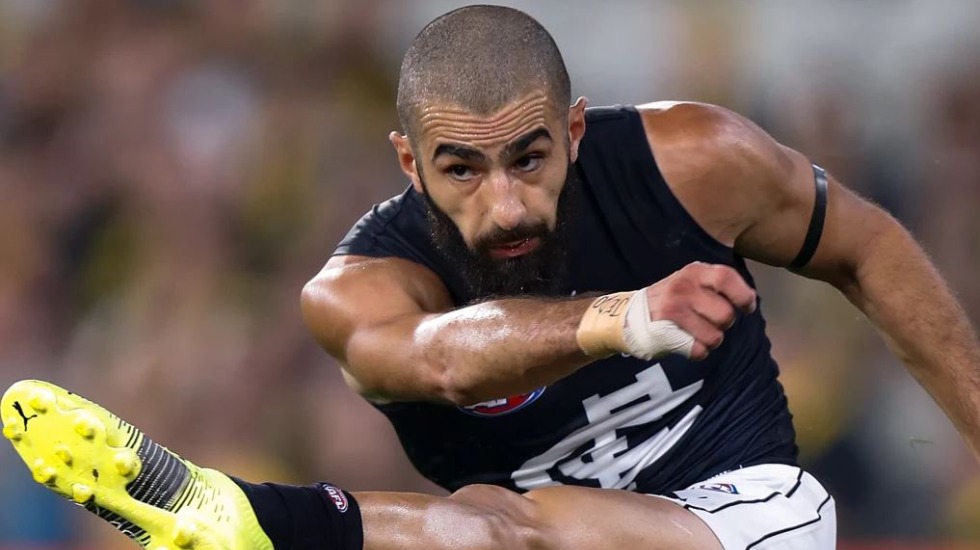Carlton recruit Adam Saad lets rip with his left foot during Thursday night’s season-opener at the MCG. Photo: GETTY IMAGES
There’s never any shortage of storylines heading into round one of an AFL season.
This year’s feast features Adam Treloar’s grudge match against Collingwood, young gun Matt Rowell’s return and the all-conquering Tigers kicking off their bid for a premiership three-peat.
Ben Rutten takes the reins full-time at Essendon, former Bomber Joe Daniher makes his Brisbane debut and the Giants-Saints clash looms as an early test of both sides’ finals credentials.
Even better, football and crowds are back in Melbourne. Up to 50,000 fans (limited by coronavirus restrictions) will pack into the MCG on Thursday and Friday nights to get the season underway.
In the background, there is pressure on coaches, including Simon Goodwin and Leon Cameron, stars like Marcus Bontempelli and Zach Merrett are entering free agency, and the debate around the competition’s future in Tasmania continues.
What is arguably the most significant watch of all this season isn’t nearly so ‘sexy’ as all that.
It is, however, familiar … It’s the ever-changing rules of the game and the effect the latest batch of tweaks and adjustments will have on the way it is played.
The constant changes have been the bane of many fans’ football lives in recent years and a quick glance at social media, internet forums or talkback radio will tell you 2021 is no different.
As if almost trolling those fans, the AFL has left confirmation of its latest rule change (the medical substitute) until little more than 24 hours before the season’s opening match.
Quarters have reverted to the full 20 minutes (plus time-on) and the interchange rotation cap has been reduced to 75 per team (down from 90 last year).
The new “stand” rule – which prohibits movement by the player on the mark – has been the most noticeable and contentious change so far.
According to Damien Hardwick, its implementation means we’ll be watching something new by the time the ball is bounced to start the Richmond-Carlton season opener.
“What I will say is it’s a different game,” the triple-premiership coach said after the Tigers’ Community Series clash with Collingwood this month.
“We took 120 uncontested marks; that’s normally a two-game total for us.
“It’s a different look and we’ll do a little bit of work on that and see whether it’s something we have to work our way through.”
PLEASE HELP US CONTINUE TO THRIVE BY BECOMING AN OFFICIAL FOOTYOLOGY PATRON. JUST CLICK THIS LINK.
Just how “different” the game becomes remains to be seen.
The end goal of the raft of changes implemented by AFL footy ops boss Steve Hocking and his team in recent seasons is more free-flowing football, a better balance between attack and defence, and ultimately more scoring.
The view is that those elements can make the “product” more entertaining.
Anyone hoping for a throwback to the Ablett-versus-Salmon style of shootout is likely to end up disappointed, but Nathan Buckley believes teams have at least been prompted to play a more attacking style of game.
“It’s definitely planted an offensive mindset in most teams,” the Collingwood coach said on the eve of his 10th season at the helm.
“I for one as a coach have got the feeling it’s about time for defences to be broken down.
“I think the rule changes, the interchange cap and the length of game are going to make that a real possibility.
“I think most coaches would be suggesting we need our offence to catch up with our D, and that focus alone should potentially open the game up.”
Buckley also warned that teams trying to pushing the ball too fast in search of higher scores would be burnt going the other way.
“If you want to go faster, you’ll miss targets and the ball’s going to be coming back pretty quick,” he said.
“I wouldn’t be surprised if we saw a more open game. If that results in scores, it will end up coming back to the offensive efficiency of each side.
“I think that will actually have a big say in where sides finish, who wins games and what the ladder looks like at the end of the year – how efficient you are with your offence when you get your opportunities.”
Most fans would probably agree an increased focus on attacking football would be a positive outcome at this point in time – not that we’ll ever reach a consensus on how best to get there.
Here’s hoping the latest changes at least dig us out of the dour, defensive grind that football has been far too often over the last decade or so.










